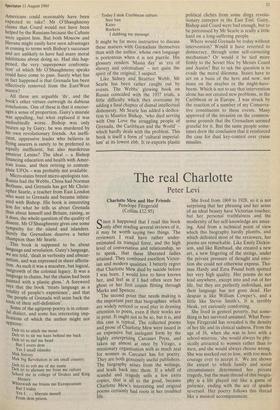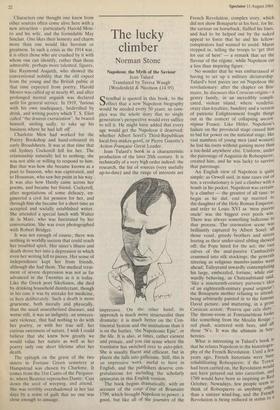The real Charlotte
Peter Levi
Charlotte Mew and Her Friends Penelope Fitzgerald (Collins £12.95) Since it happened that I read this book Oonly after reading several reviews of it, it may be worth saying two things. The reviewers I read have rather under- estimated its tranquil force, and the high level of conversation and relationship, so to speak, that these liberated ladies attained. They combined excellent Victor- ian and modern qualities. I bitterly regret that Charlotte Mew died by suicide before I was born. I would love to have known her, and feel as if I had often seen her ghost or her first cousin flitting through Marks and Spencer.
The second point that needs making is the important part that biographies which are widely noticed or read play in drawing attention to poets, even if their works are in print. It ought not to be so, but it is, and this case is typical. The collected poems and prose of Charlotte Mew were issued in an expensive but inelegant form by the highly enterprising Carcanet Press, and taken up almost at once by Virago, a missionary organisation with as much zeal for women as Carcanet has for poetry. They are both genuinely useful publishers. The biography arises from the writings, and leads back into them. If a whiff of scandal and tragedy sells a few extra copies, that is all to the good, because Charlotte Mew's interesting and original poems certainly had roots in her troubled life.
She lived from 1869 to 1928, so it is not surprising that her phrasing and her sense of an ideal beauty have Victorian touches; but her personal truthfulness and the modernity of her self-knowledge are amaz- ing. And from a technical point of view which this biography hardly plumbs, and which defeated most of the reviewers, her poems are remarkable. Like Emily Dickin- son, and like Rimbaud, she created a new art, a new fingering of the strings, under the private pressure of thought and emo- tion she could not otherwise express. Tho- mas Hardy and Ezra Pound both spotted her very high quality. Her poems do not lead anywhere, except into and out of her life, but they are perfectly individual, and their language has not gone dead. Her despair is like William Cowper's, and a little like Stevie Smith's. It is terribly bleak, yet curiously comforting.
She lived in genteel poverty, but some- thing in her survived untamed. What Pene- lope Fitzgerald has revealed is the density of her life and its clinical sadness. From the age of 16, when she was in love with a school-mistress, 'she would always be phy- sically attracted to women rather than to men, and she would always choose wrong. She was marked out to lose, with too much courage ever to accept it.' We are shown the extent to which family and social circumstances determined her private tragedy, but the main thread of this biogra- phy is a life played out like a game of patience, ending with the ace of spades reversed. Her poetry follows this thread like a musical accompaniment. Characters one thought one knew from other sources often come alive here with a new attraction - particularly Harold Mon- ro and his wife, and the formidable May Sinclair. One likes their honesty and charm more than one would like heroism or greatness. In such a crisis as the 1914 war, it is often those who are crushed by it with whom one can identify, rather than those admirable, perhaps more talented, figures, like Raymond Asquith, who showed the conventional nobility that the old expect from the young and the British public at that time expected from poetry. Harold Monro was called up at nearly 40, and after prolonged mental anguish was declared unfit for general service. In 1919, 'furious with his own inadequacy, bedevilled by drink, and writing poetry which T. S. Eliot called "the dourest excruciation", he braced himself, smiling sadly, to take up his business where he had left off .
Charlotte Mew had worked for the Poetry Bookshop and hand-coloured its early Broadsheets. It was at that time that old Sydney Cockerell fell for her. The relationship naturally led to nothing; she was not able or willing to respond to him. But that was how she became known as a poet to Sassoon, who was captivated, and to Housman, who saw her point in his way. It was also how Hardy came across her poems, and became her friend. Cockerell, after negotiations of some delicacy, en- gineered a civil list pension for her, and through him she became for a short time an accepted and socially established writer. She attended a special lunch with Walter de la Mare, who was fascinated by her conversation. She was even photographed with Robert Bridges.
It was not enough of course; there was nothing in worldly success that could reach her troubled spirit. Her sister's illness and death drove her into a depression in which even her writing fell to pieces. Her sense of independence kept her from friends, although she had them. The medical treat- ment of severe depression was not as far advanced in the Twenties as it is today. Like the Greek poet Sikelianos, she died by drinking household disinfectant, though in his case it was by mistake for medicine, in hers deliberately. Such a death is more gruesome, both morally and physically, than the usual anaesthetised diseases, and worse still, it was an indignity, an unneces- sary violence, that had nothing to do with her poetry, or with her true self, her curious sweetness of nature. I wish I could believe that she knew how greatly we would value her nature as well as her poetry only one short lifetime after her death.
The epitaph on the grave of the two sisters in Fortune Green cemetery at Hampstead was chosen by Charlotte. It comes from the 31st Canto of the Purgator- io, where Beatrice reproaches Dante: 'Cast down the seed of weeping. and attend.' She was terribly overshadowed in her last days by a sense of guilt that no one was close enough to assuage.







































 Previous page
Previous page